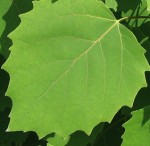 Big tooth aspen is a deciduous tree native to eastern North America from Newfoundland and Manitoba, south to Virginia, Kentucky, and Iowa where it grows in open woods, edges of clearings and other disturbed sites. It is a member of the willow family, Salicaceae, that also includes poplars, aspen, and cottonwoods. The trees may be single stemmed or clump-forming and have smooth, beige to green bark that becomes gray and deeply furrowed with maturity. The oval to egg-shaped leaves are two to four inches long and 1 ¾ to 3 ½ inches wide, and are dark green until turning yellow in the fall. They have sinuate dentate margins , white woolly hair on both surfaces when young, and long flattened petioles that enable them to tremble in the wind. Catkins hang from leaf axils of 1 year old branch twigs and carry male or female flowers on separate trees in spring. The male flowers are 3 ½” long and have red stamens while the female flowers are 1 ¼ “-3” long, have red stigmas, and produce rounded fruit with cottony seeds. Bigtoothed aspen is fast growing, short lived, and tolerant of a wide range of soils but intolerant of shade. They are pioneer species on disturbed sites and are useful as specimens trees, shade trees, patio trees, screen, or windbreaks. The generic name Populus is the Latin name for the tree. The specific epithet grandidentata comes from the Latin words grandis meaning large, and dens, meaning tooth, referring to the coarsely toothed margins of the leaves.
Big tooth aspen is a deciduous tree native to eastern North America from Newfoundland and Manitoba, south to Virginia, Kentucky, and Iowa where it grows in open woods, edges of clearings and other disturbed sites. It is a member of the willow family, Salicaceae, that also includes poplars, aspen, and cottonwoods. The trees may be single stemmed or clump-forming and have smooth, beige to green bark that becomes gray and deeply furrowed with maturity. The oval to egg-shaped leaves are two to four inches long and 1 ¾ to 3 ½ inches wide, and are dark green until turning yellow in the fall. They have sinuate dentate margins , white woolly hair on both surfaces when young, and long flattened petioles that enable them to tremble in the wind. Catkins hang from leaf axils of 1 year old branch twigs and carry male or female flowers on separate trees in spring. The male flowers are 3 ½” long and have red stamens while the female flowers are 1 ¼ “-3” long, have red stigmas, and produce rounded fruit with cottony seeds. Bigtoothed aspen is fast growing, short lived, and tolerant of a wide range of soils but intolerant of shade. They are pioneer species on disturbed sites and are useful as specimens trees, shade trees, patio trees, screen, or windbreaks. The generic name Populus is the Latin name for the tree. The specific epithet grandidentata comes from the Latin words grandis meaning large, and dens, meaning tooth, referring to the coarsely toothed margins of the leaves.
Type: Deciduous tree
Outstanding Feature: Trembling leaves
Form: Oval
Growth Rate: Rapid
Bloom: . Male and female pendulous catkins on separate trees; male flowers 3 ½” long with red stamens, the female flowers 1 ¼ “-3” long with red stigmas
Size: 30-80’ H x 20-30’ W
Light: Full sun
Soil: Average, moderately moist, well-drained, neural to acidic
Hardiness: Zones 3-7
Care: Low maintenance
Pests and Diseases: Disease and pest prone the most common being hypoxylon cander, gypsy moth, ambrosia beetle; various rots, fungi, and root decay all contribute to health problems.
Propagation: Seed, root cuttings, division of sprouts from dormant clumps